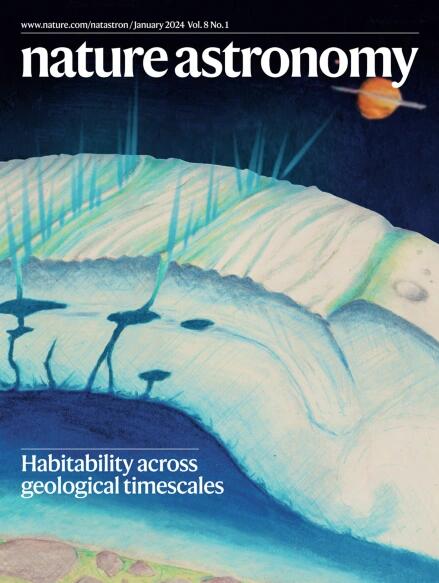A brief encounter with an energetic cosmic neutrino
IF 12.9
1区 物理与天体物理
Q1 ASTRONOMY & ASTROPHYSICS
引用次数: 0

与高能宇宙中微子的短暂相遇
2023年2月13日,刚过UTC 01:00,一个高能μ子穿过基于海水的KM3NeT中微子实验的传感器场,激发了切伦科夫光的爆发,引发了28,086次探测。该事件被命名为KM3-230213A (Nature 638, 376-382;2025)。图像中,介子的路径用红色表示,切伦科夫光锥的形状用蓝色表示。μ子通过随机辐射过程损失能量,如轫致辐射、对产生和光核反应;这些过程激发出产生切伦科夫光的电磁级联,切伦科夫光被沿21条检测线(如垂直线所示)间隔排列的光学探测器模块捕捉到。每个光模块包含31个光电倍增管,可实现4π立体覆盖。在图像中,探测到的事件由聚集在光学模块周围的球体表示,并沿着光电倍增管的方向排列,颜色指示了第一次触发撞击的时间(图b中的特写)。从撞击的序列中,可以确定μ子的方向和能量。外推中微子进入太空的路径导致没有明显的瞬态物体可能是一个潜在的起源。活动星系核和耀blazar可能是宇宙中微子的来源,尽管在KM3-230213A的99%置信范围内发现了12个,但没有一个被认为是令人信服的。另一个可能的来源是超高能量宇宙射线与河外背景光或宇宙微波背景的相互作用,产生所谓的宇宙中微子。以前没有发现过。
本文章由计算机程序翻译,如有差异,请以英文原文为准。
求助全文
约1分钟内获得全文
求助全文
来源期刊

Nature Astronomy
Physics and Astronomy-Astronomy and Astrophysics
CiteScore
19.50
自引率
2.80%
发文量
252
期刊介绍:
Nature Astronomy, the oldest science, has played a significant role in the history of Nature. Throughout the years, pioneering discoveries such as the first quasar, exoplanet, and understanding of spiral nebulae have been reported in the journal. With the introduction of Nature Astronomy, the field now receives expanded coverage, welcoming research in astronomy, astrophysics, and planetary science. The primary objective is to encourage closer collaboration among researchers in these related areas.
Similar to other journals under the Nature brand, Nature Astronomy boasts a devoted team of professional editors, ensuring fairness and rigorous peer-review processes. The journal maintains high standards in copy-editing and production, ensuring timely publication and editorial independence.
In addition to original research, Nature Astronomy publishes a wide range of content, including Comments, Reviews, News and Views, Features, and Correspondence. This diverse collection covers various disciplines within astronomy and includes contributions from a diverse range of voices.
 求助内容:
求助内容: 应助结果提醒方式:
应助结果提醒方式:


